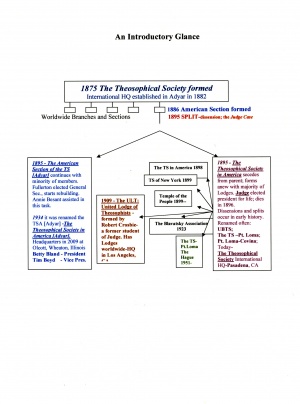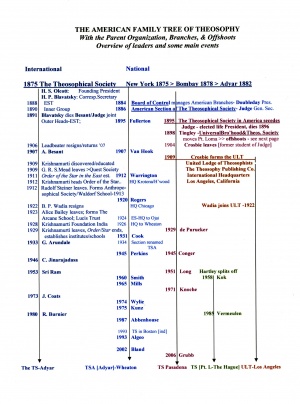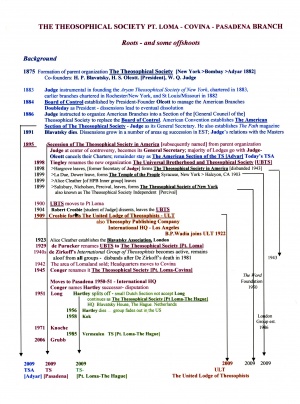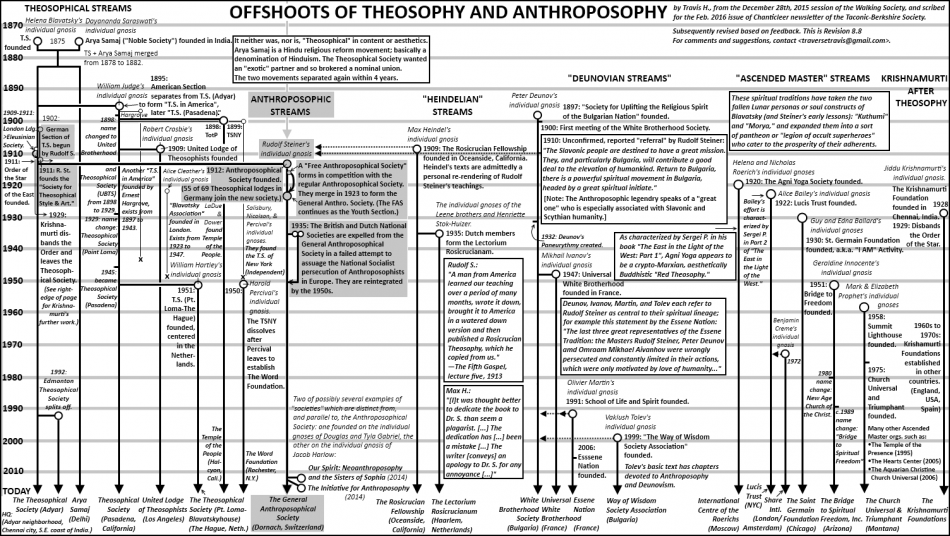Theosophical Movement: Difference between revisions
| (4 intermediate revisions by the same user not shown) | |||
| Line 5: | Line 5: | ||
For an excellent impartial '''overview of the Theosophical Movement''' see | For an excellent impartial '''overview of the Theosophical Movement''' see | ||
'''[https://www.theosophyforward.com/index.php/theosophy/756-theosophy-and-the-theosophical-societies-.html "Theosophy and the Theosophical Societies"]''' by Dr. James Santucci.<ref>Published 04 March 2013 in ''Theosophy Forward''.</ref> | '''[https://www.theosophyforward.com/index.php/theosophy/756-theosophy-and-the-theosophical-societies-.html "Theosophy and the Theosophical Societies"]''' by Dr. James Santucci.<ref>Published 04 March 2013 in ''Theosophy Forward''.</ref> | ||
== History of the term == | |||
The first use of the term "Theosophical Movement" has not been identified. [[A. P. Sinnett]] wrote an article entitled "The Theosophical Movement" for ''The Calcutta Review'' that was republished in ''Theosophical Siftings'', 1888-1889. His use of phrase so prominently implies that the reading public was already familiar with the term. | |||
An early use appears in a review of an 1894 lecture tour by [[Constance Wachtmeister|Countess Wachtmeister]], appearing in [[The Path (periodical)|''The Path'']]: "Very great help had been given to the Theosophical movement by a sermon against Theosophy preached by the Rector of the Island, the sermon stirring up the population to find out all about Theosophy."<ref>Anonymous, "Mirror of the Movement" ''The Path'' 9 No. 7 (October, 1894): 31.</ref> | |||
President-Founder [[Henry Steel Olcott]] used the term "Theosophical movement" in his address to the 1897 convention, as reported in a supplement to [[The Theosophist (periodical)|''The Theosophist'']]. Also in 1897, the cover of the periodical [[Theosophy (periodical)|''Theosophy'']] was stated to be "a magazine devoted to The Theosophical Movement, the Brotherhood of Humanity, the Study of Occult Science and Philosophy, and Aryan Literature," so editor [[Ernest Temple Hargrove]] was using the term.<ref>Pat Deveney, "Theosophy" IAPSOP database at [http://iapsop.com/archive/materials/theosophy/|http://iapsop.com/archive/materials/theosophy/]. Illustration of April 1897 cover of ''Theosophy''.</ref> | |||
Use of the phrase quickly became widely accepted in all the major Theosophical organizations, as reflected in their magazines. [[The Theosophical Review (periodical)|''The Theosophical Review'']] was using the term in 1900; [[Theosophical Quarterly (periodical)|''Theosophical Quarterly'']] in 1912; [[The Theosophic Messenger (periodical)|''The Theosophic Messenger'']] in 1913; and by the 1930s in [[The Theosophical Forum (periodical)|''The Theosophical Forum '']] and many other periodicals. Beginning in 1930, the United Lodge of Theosophists in Mumbai, India began publishing a magazine with the title [[The Theosophical Movement (periodical)|''The Theosophical Movement'']]. | |||
== Mahatma Morya on Theosophical Movement == | |||
An important use of the term '''Theosophical Movement''' came from [[Mahatma]] [[Morya]]. When the first [[Theosophical Society]] president, [[Henry Steel Olcott|Colonel Olcott]], was on his death-bed, he dictated a final article to the membership called "A Recent Conversation with the Mahatmas," published in the February 1907 issue of [[The Theosophist (periodical)|''The Theosophist'']]. He did not know how to end the article, and Master M appeared, finishing it for him. | |||
<blockquote> | |||
Let those who believe in our existence, and that we are behind the Theosophical Movement, also that we shall continue to employ it as an agency for the uplifting of mankind, know, that we are sometimes forced to employ imperfect instruments (because of the lack of perfect ones) for our work; therefore, cease from such turmoil and strife, and from causing such disturbance in the Unity of Brotherhood, and thus weakening its strength; but instead, work together in harmony, to fit yourselves to be useful instruments to aid us, instead of impeding our work. We who are behind the Theosophical Movement are powerless, sometimes, to prevent the checks and disturbances that must unavoidably arise, because of the Karma of individual members; but you can aid us much by refusing to take part in such disturbances, | |||
and by living true to the highest possible ideals of Theosophy. Should any event bring forth seeming injustice, have faith in the Law, that never fails to adjust matters. Cease rushing headlong into strife, or taking part in dissensions! Hold together in brotherly love, since you are part of the Great Universal Self. Are you not striving against yourselves? Are not your Brother’s sins your own? Peace! Trust in us.<ref>Marie R. Hotchner, "Memories of Colonel Olcott" ''World Theosophy'' 3 no. 2 (February, 1933): 123. Mrs. Hotchener attended Olcott in his last days, and took dictation as his secretary, so this is a first-person account.</ref> | |||
</blockquote> | |||
== Family tree of Theosophical organizations == | == Family tree of Theosophical organizations == | ||
| Line 83: | Line 102: | ||
== Additional resources== | == Additional resources== | ||
=== Books === | |||
* [https://www.filosofiaesoterica.com/the-theosophical-movement/ The Theosophical Movement] by William Q. Judge | * [https://www.filosofiaesoterica.com/the-theosophical-movement/ The Theosophical Movement] by William Q. Judge | ||
* Blavatsky, ''H.P. Collected Writings''. Fifteen volumes. Wheaton: Theosophical Publishing House, 1950–91. | * Blavatsky, ''H.P. Collected Writings''. Fifteen volumes. Wheaton: Theosophical Publishing House, 1950–91. | ||
| Line 91: | Line 111: | ||
* Mills, Joy. ''One Hundred Years of Theosophy''. Wheaton: Theosophical Publishing House, 1987. | * Mills, Joy. ''One Hundred Years of Theosophy''. Wheaton: Theosophical Publishing House, 1987. | ||
* Santucci, James M. “The Theosophical Society.” In James M. Lewis and Jesper Aagaard Petersen, eds. ''Controversial New Religions''. New York: Oxford University Press, 2004. | * Santucci, James M. “The Theosophical Society.” In James M. Lewis and Jesper Aagaard Petersen, eds. ''Controversial New Religions''. New York: Oxford University Press, 2004. | ||
=== Video === | |||
* [https://www.youtube.com/watch?v=euU-IRsiRbs The Theosophical Movement and Its Importance] by John Cooper. 1990. 60 minutes. | |||
== Notes == | == Notes == | ||
<references/> | <references/> | ||
[[Category:History|Theosophical Movement]] | [[Category:History|Theosophical Movement]] | ||
Latest revision as of 16:25, 12 November 2024
Theosophical Movement is a broad term indicating organizations and philosophies of the modern era influenced by the teachings of Helena Petrovna Blavatsky and her original Theosophical Society, founded in 1875. Theosophy and its offshoots have profoundly influenced education, language, and the arts. Other associated movements and philosophies include New Thought, Spiritualism, Vegetarianism, anti-vivisection societies, animal rights, interfaith activities, alternative medicine, and modern culture. Theosophists were heavily involved in the introduction of Eastern religious concepts (like reincarnation, karma, yoga) into the West; cremation into the United States; Buddhist education in Sri Lanka; and political and social change in India.
Some of the influential people who were Theosophists or closely affiliated with the Theosophical Society include: Thomas Alva Edison, Mahatma Gandhi, Dr. Maria Montessori, Dr. Albert Einstein, William Butler Yeats, Gen. Abner Doubleday, Dr. Albert Schweitzer, Maxim Gorky, Edgar Rice Burroughs, William James, Sir William Crookes, D. H. Lawrence, Paul Klee, Wassily Kandinsky, D. T. Suzuki, and Alexander Scriabin.
For an excellent impartial overview of the Theosophical Movement see "Theosophy and the Theosophical Societies" by Dr. James Santucci.[1]
History of the term
The first use of the term "Theosophical Movement" has not been identified. A. P. Sinnett wrote an article entitled "The Theosophical Movement" for The Calcutta Review that was republished in Theosophical Siftings, 1888-1889. His use of phrase so prominently implies that the reading public was already familiar with the term.
An early use appears in a review of an 1894 lecture tour by Countess Wachtmeister, appearing in The Path: "Very great help had been given to the Theosophical movement by a sermon against Theosophy preached by the Rector of the Island, the sermon stirring up the population to find out all about Theosophy."[2]
President-Founder Henry Steel Olcott used the term "Theosophical movement" in his address to the 1897 convention, as reported in a supplement to The Theosophist. Also in 1897, the cover of the periodical Theosophy was stated to be "a magazine devoted to The Theosophical Movement, the Brotherhood of Humanity, the Study of Occult Science and Philosophy, and Aryan Literature," so editor Ernest Temple Hargrove was using the term.[3]
Use of the phrase quickly became widely accepted in all the major Theosophical organizations, as reflected in their magazines. The Theosophical Review was using the term in 1900; Theosophical Quarterly in 1912; The Theosophic Messenger in 1913; and by the 1930s in The Theosophical Forum and many other periodicals. Beginning in 1930, the United Lodge of Theosophists in Mumbai, India began publishing a magazine with the title The Theosophical Movement.
Mahatma Morya on Theosophical Movement
An important use of the term Theosophical Movement came from Mahatma Morya. When the first Theosophical Society president, Colonel Olcott, was on his death-bed, he dictated a final article to the membership called "A Recent Conversation with the Mahatmas," published in the February 1907 issue of The Theosophist. He did not know how to end the article, and Master M appeared, finishing it for him.
Let those who believe in our existence, and that we are behind the Theosophical Movement, also that we shall continue to employ it as an agency for the uplifting of mankind, know, that we are sometimes forced to employ imperfect instruments (because of the lack of perfect ones) for our work; therefore, cease from such turmoil and strife, and from causing such disturbance in the Unity of Brotherhood, and thus weakening its strength; but instead, work together in harmony, to fit yourselves to be useful instruments to aid us, instead of impeding our work. We who are behind the Theosophical Movement are powerless, sometimes, to prevent the checks and disturbances that must unavoidably arise, because of the Karma of individual members; but you can aid us much by refusing to take part in such disturbances, and by living true to the highest possible ideals of Theosophy. Should any event bring forth seeming injustice, have faith in the Law, that never fails to adjust matters. Cease rushing headlong into strife, or taking part in dissensions! Hold together in brotherly love, since you are part of the Great Universal Self. Are you not striving against yourselves? Are not your Brother’s sins your own? Peace! Trust in us.[4]
Family tree of Theosophical organizations
In 2009, Dorothy Bell of the Theosophical Society in Australia (associated with the TS based in Adyar, India) worked out a series of diagrams accompanying a philosophical article called "Roots and Shoots: A Preface." She wrote:
To some extent, the events and timelines of the American Family Tree of Theosophy disguise the true nature of its evolutionary life — the cycles and patterns of growth, decline, and rebirth and within them, the struggles to bring the original purpose of the Theosophical Society into fruition.
New seasons have seen some branches of the Family Tree thicken and extend offshoots, as others wither and die. In pushing up from underground and finding new garden beds, new runners from the main roots have found their own place in the sun — while appearing separate. On the original tree, storms have damaged branches sometimes splitting them asunder. And in the fullness of cycles, leaves have fallen and others have grown, taking their place on twigs and other offshoots, pushing out to find the light, and responding to the same living, vibrating impulse for life expression and expansion.
The impulse of the Heart that sowed its seed in 1875 and grew the outer vehicle — The Theosophical Society — to carry the Light of Wisdom into the world, is still with us today in the hearts of many who are responding anew to its original call, but who find themselves under different labels, in different boxes, and in different territories.
Over the years, lines of demarcation have been drawn in the sand, fences have been built, territories established and guarded. In time, lines drawn in sand lose their definition, but not so those lines in the mind that are caught in memory, in history. In the past, perceptions of lost ideals, wrong directions, and diluted teachings bred disharmony, division, and separation — and new patterns of birth, growth and renewal, or decline and decay, evolved.
But the original impulse that produced the seed and the tree, the branches and offshoots, the underground runners with their place in the sun, is still within, seeking expression and fulfillment. There is no need to change any boundaries, annex other territories, or dissolve any compartments, save in the prison of the mind. And a mind that is crippled by memory — by separation and fear — can never be free. We can find our own place in the sun by going beyond the bondage of the past and serving that impulse wherever we be. That is our territory; that is our center; that is our Theosophical family.
The American Family Tree of Theosophy
The aim has been to produce something accessible, simple and useful. It is an initiative of the President, Betty Bland, in response to those members at the Joy Mills Krotona Invitational 2009 who expressed interest in finding out more about the bigger picture of the Theosophical movement in America — beyond our own organization — The Theosophical Society in America [Adyar]. The following diagrams, while overlapping and becoming more complex, are a work in progress, as they attempt to describe, in a restricted mode of presentation and from a range of sources, some of the significant events of the past that have shaped the American Family Tree of Theosophy. They provide a springboard for browsers to continue the exploration for themselves.
In seeking information, decisions had to be made about what to include or exclude, and there will always be debate about things that should have been included. For example, the diagrams do not give details about:
- The major developments in the history of the present Theosophical Society of America (TSA) [Adyar] which is headquartered in Wheaton, Illinois [see Joy Mills, below, for a comprehensive account of the first 100 years]
- The early days when Canadian Lodges were managed by the American Board of Control and Section
- The independent Lodges that exist in the United States today, such as in Boston
- Those many groups that have formed around Theosophists or others who have been deeply influenced by Theosophy and by both Eastern and Western esoteric literature
- The valuable journals and magazines that many groups have produced
Resources
As in any journey of discovery and exploration, there were signposts to follow. The following reference books provided both information and food for thought:
- Mills, Joy. 100 Years of Theosophy: A History of the Theosophical Society in America. Wheaton, Ill.: Theosophical Publishing House, 1987.
- Spinks, F. P. Theosophists Reunite!. Boston: The Christopher Publishing House, 1958.
And where would an amateur sleuth be without the Google tool? The following Web sites, some more comprehensive than others, are fundamental and lead into the labyrinth of linkages of organizations, personalities, and histories that weave the stories of the past that are also our stories and our dreams. As a wise old woman, a teacher, once said, “Every story is an aspect of the truth... and everyone who ever was, is, or will be, is an aspect of you—as you are an aspect of them.”
Organization Home page The Temple of the People http://www.templeofthepeople.org/ The Theosophical Society [Adyar] http://www.ts-adyar.org/ The Theosophical Society [Pasadena] http://www.theosociety.org/ The Theosophical Society [Pt. Loma-The Hague] http://www.blavatskyhouse.org/ The Theosophical Society in America http://www.theosophical.org/ The United Lodge of Theosophists http://www.ult.org/ The Word Foundation http://www.thewordfoundation.org/
Dorothy Bell later expanded the "American Family Tree of Theosophy" section into an article for Winter, 2010 issue of Quest magazine, called "Roots and Shoots: Theosophy in the United States." It is available on the Quest magazine web page.
Organogram
Early in 2016, Travis Henry published an organizational diagram incorporating the history of the Anthroposophical Society and other groups into a fairly comprehensive view of the Theosophical Movement. Whereas Dorothy Bell's mission was to focus was on history from an American perspective, Mr. Henry viewed history more broadly. He published his "Organogram" in the February, 2016 issue of Chanticleer, the newsletter of the Berkshire-Taconic Branch of the Anthroposophical Society.
Additional resources
Books
- The Theosophical Movement by William Q. Judge
- Blavatsky, H.P. Collected Writings. Fifteen volumes. Wheaton: Theosophical Publishing House, 1950–91.
- Chin, Vicente Hao, Jr., ed. The Mahatma Letters to A. P. Sinnett in Chronological Sequence. Adyar: Theosophical Publishing House, 1998.
- Gomes, Michael. The Dawning of the Theosophical Movement. Wheaton, Ill.: Theosophical Publishing House, 1987.
- Gomes, Michael. HPB Teaches: An Anthology. Adyar, Chennai, India: Theosophical Publishing House, 1992.
- Harris, Philip S., ed. Theosophical Encyclopedia. Quezon City, Philippines: Theosophical Publishing House, 2006. This material has been merged into the Theosophy World website.
- Mills, Joy. One Hundred Years of Theosophy. Wheaton: Theosophical Publishing House, 1987.
- Santucci, James M. “The Theosophical Society.” In James M. Lewis and Jesper Aagaard Petersen, eds. Controversial New Religions. New York: Oxford University Press, 2004.
Video
- The Theosophical Movement and Its Importance by John Cooper. 1990. 60 minutes.
Notes
- ↑ Published 04 March 2013 in Theosophy Forward.
- ↑ Anonymous, "Mirror of the Movement" The Path 9 No. 7 (October, 1894): 31.
- ↑ Pat Deveney, "Theosophy" IAPSOP database at [1]. Illustration of April 1897 cover of Theosophy.
- ↑ Marie R. Hotchner, "Memories of Colonel Olcott" World Theosophy 3 no. 2 (February, 1933): 123. Mrs. Hotchener attended Olcott in his last days, and took dictation as his secretary, so this is a first-person account.



